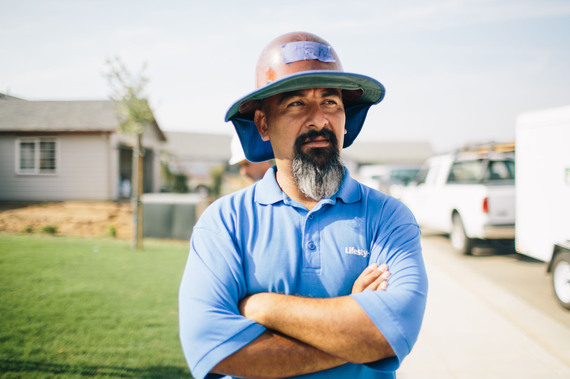Like a lot of construction workers, Jesus (Jesse) Magallenes took a serious hit during the Great Recession. California's Central Valley, where Jesse lives in the town of Visalia, had it particularly rough.
Jesse got by taking odd jobs wherever he could -- driving a forklift or whatever he could get. Working any part-time, minimum wage jobs he could scrape together -- sometimes juggling four or five tiny jobs in a week -- he still wasn't making ends meet.
"I was making $300 a week and I had to move back into my parents' house," he recalls. He helped his parents out with rent, living there for three years while working multiple jobs and looking for something better. He found it in California's growing clean energy economy.
I know that when you mention "California" and "clean energy" in the same breath, all sorts of stereotypes pop into people's heads: tech moguls driving Teslas and aging hippies in Marin with solar powered hot tubs. But that's not the real story. The real story is a new economy that's cleaning the air and protecting health in our most polluted communities while bringing good jobs and life-changing opportunities to neighborhoods that have had too little of either.
Jesse heard from friends that there were jobs opening up in the Valley installing solar panels. "I found out that there were all these government programs to help out homeowners finance solar and make it easy for people to get it," he recalls, so he decided to seek training.
While training at a local technical school, he volunteered with GRID Alternatives, a national nonprofit that provides job training in solar installation and no- to very-low-cost solar for qualified low-income homeowners. GRID manages SASH, California's Single Family Affordable Solar Homes program, helping families get solar power who otherwise couldn't afford it. He quickly became a team leader, and this hands-on experience and training eventually led Jesse to a full-time job at a commercial solar firm, where he is now a crew leader. He also runs a side business cleaning solar panels, and is doing well enough that he and his wife recently bought a house.
Thanks to two smart California laws, AB 32 and SB 535, SASH and similar programs are now getting a $75 million boost in the current fiscal year, and will continue to grow over time.
Under these laws, California charges big, industrial polluters for the filth they put into the air. That money then goes into a fund that finances projects to further clean our air, save energy and promote clean power sources like solar and wind. And by law at least one quarter of those funds must go to projects that help economically disadvantaged, highly polluted communities.
That means more jobs for people like Jesse. And more hope for people like Maria Zavala and her family in the town of Madera -- another Central Valley community that was devastated by the economic downturn.
Two years ago, Maria was all set to start building a new home for herself with a hand from Self Help Enterprises, a nonprofit that allows low-income individuals in the San Joaquin Valley to use their "sweat equity" as the down payment on a home. But just before construction began, her husband was diagnosed with a fast-moving cancer in July 2013 and died that October.
But, despite the grief and the added financial burdens, Maria carried on with her plans to build the new home, with help from her mother, sister, and sons. Maria and her daughter Erika moved from their small apartment into this new home -- modest but comfortable -- in Madera's Park neighborhood last August 11, but then tragedy struck again. At the end of August Maria's sister had an aneurysm. She had surgery and then was in a coma until she passed away September 11.
It's been tough, but Maria is coping. At least her finances have been made easier by a solar power system she got from GRID Alternatives for the new house -- another SASH-funded project that exists because of California's commitment to clean energy. Her electricity bill has dropped from $200 a month at her old apartment to as low as $1.50 now.
But the laws that are helping people like Jesse and Maria face constant attack. Big Oil -- often laughably posing as a friend of working families and the poor -- remains the biggest lobby in California, outspending such heavy hitters as the Chamber of Commerce. Most of that spending is going to weaken California's smart climate and clean energy laws and to fight restrictions on fracking.
This matters, and not just for California. The precedent being set here -- if we can hold onto it -- can literally change the world. I invite you to learn more about California's climate and clean energy laws and meet the real families those laws are helping at UpLiftCA.org.
